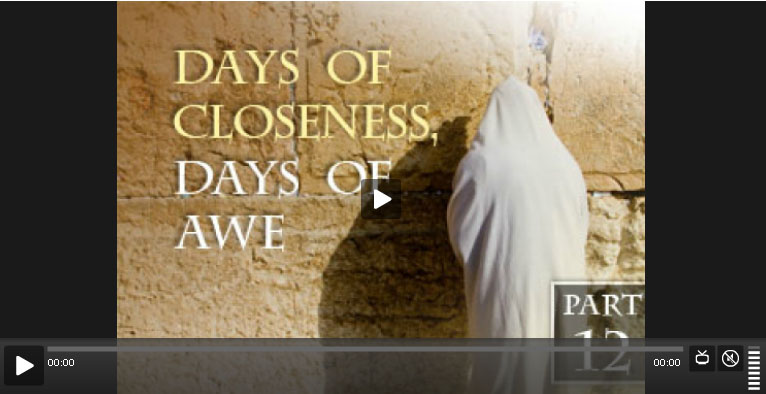
Join Naaleh
as we expand from
the Pillar of Torah Study
to include Prayer
and Chessed with the
Naaleh Worldwide
Bikur Cholim Project.

|
Refua Shleima List
Yitzchak Aryeh ben Reva Leah
Two and a half year old boy with a brain tumor
Esther Leora bas Chava
Reuven Peretz ben Fayge Chaya
Dovid ben Bracha
Michelle bas Noach
Avigail Rachel bas Zahava SarahHillel ben Shimon
Rachel bas Simcha
Natanel Menachem Avroham ben Rochel
Rochel bas Zahava
|
Student Testimonial
"Thank you so so much for the many hours of shiurim I have already benefited so much from. I've never learned so much in my life in such a concentrated span of time, and it makes tons of difference to doing household chores when I can be listening to words of Torah as I go.I especially enjoy Rebbetzin Heller's Q & A sessions" -YR, Beitar Israel Send in your comments to [email protected] and they might appear it an upcoming newsletter!
|
|
|
|
|
|
Dear Naaleh Friend,
In preparation for Rosh Hashana we have featured on Naaleh.com this week an assortment of our popular Elul and Rosh Hashana classes, that you can view now by clicking on the images
below. Be sure to checkout our homepage as well to see even more inspirational videos and shiurim! 
  **Questions of business agreements come up daily. Dayan Shlomo Cohen answers these real life issues with clarity and precision. Check out the new class Ask the Dayan, on Naaleh.com, and send your business related halacha questions to [email protected] for the next segment of Ask the Dayan!
Be sure to check out this week's Torat Imecha below and view the printable version here.
Shabbat Shalom,
Ashley Klapper and the Naaleh Crew
|
|
Dedicated in memory of Rachel Leah bat R' Chaim Tzvi
Torat Imecha- Women's Torah
|
Endless Circle
Based on a Naaleh.com class by Rabbi Moshe Weinberger

Long ago, philosophers debated the question, from where does a king draw his power to rule? The majority consensus was that although the king gets a stamp of approval from the Creator, the essence of kingship is drawn from the will of the people. If one looks in Tanach, the appointment of a king was in response to the people coming and asking for it. "Vayehi beshurun melech," the kingship of Hashem only becomes possible, "Bishasef roshei am," when the people gather together as one and want to crown Him.
Anything that stems from the side of holiness exists in a way where its start and end are connected. The first mitzvah in the Torah is, "Be fruitful and multiply," and the last mitzvah is to write a Sefer Torah. The purpose of bringing children into the world is to bring more Torah and Judaism into the world. It is like a circle that has no beginning or end. When the Jewish people join together, there's no longer a linear existence where we have something above and below. In a circle everything is equidistant from the center. In the world of holiness even that which is at the lowest point is connected in some way to greatness. It has something unique that distinguishes it so that every point in the circle depends on it and looks up to that aspect of kedusha.
Rabbi Weinberger recounts, "In all the years I taught 12th grade boys, there was always a boy at the lowest level in learning. I would take upon myself to find out what his aspect of greatness was. There was always something I could hone in on, either he was at the top in tzedakah or chesed or something else. And then the question was how to bring that out. Once he was able to shine, it affected him in all aspects. Even his learning improved. Every Jew is a part of the circle and in that respect even one who seems to be at the end is connected to the top. In the same way, one who is great may have an aspect of lowliness, a certain point of the person that is weak and in need of others.
Hashem surrounds all worlds. In Kitvei Ari, this is called igulim, circles. We find this theme repeated in different customs we have. We eat round challot on Rosh Hashana. In a Jewish family, although each member has different responsibilities, in essence everything flows in the form of igulim. The traditional Jewish way of dancing is always in a circle. Even if it is two people together, it's always within the circle.
Something which is finite has a beginning and end. But that which comes from the world of the spirit has no boundaries. Rabbeinu Bachya quotes the Gemara that in the future the tzaddikim will form a dance. Hashem will sit in the center and everyone will point and say, "Zeh Hashem kivini lo." The dance is described as a circle without a beginning or end and is a parable to the infinite pleasure of the future world.
Hashem's boundless light is referred to in the writings of the Arizal as igulim, as opposed to other ways that reveal Hashem's light, which are yosher, linear. Every Jew experiences Hashem's light in a different way depending on the time, place, and level he is at. This refers to the ohr haEloki hamitzumtzam. All of this is a reflection of an experience that comes from the linear expression of Hashem's light that fills all worlds. But igulim is drawn from a higher aspect of the infinite light of Ein Sof, which is a circle in a world that surrounds all worlds. The different levels of time and space don't exist here at all and on this plane everything is a part of the bigger circle that encompasses all worlds and is without limitations and constrictions.
After the cleansing period of Rosh Hashana and Yom Kippur we dance in circles. There's no beginning or end, we are all one. The seven hakafot of Hoshana Rabba, the dancing on Simchat Torah, are all in the world of igulim. There we can sense the otherworldly, infinite pleasure of Hashem's light surrounding us. May it give us the strength to face the coming new year with faith and joy.
|
The sages say that the two tablets were equal on both sides. But we know that the commandments between man and Hashem have many more words than the commandments between man and man. The Matnas Chaim explains that the commandments between man and man were written in larger letters. This teaches that though it may be a lot easier to get a spiritual high from mitzvot between man and Hashem, mitzvot between man and man play an equally important role in connecting us to the Creator. Rav Hillel points out that people will pay exorbitant amounts for a beautiful etrog, but when it comes to keeping away from unfair profits they are surprisingly ready to bend the rules. We have to be vigilant on both sides.
One of the acronyms of Elul is, "Ish l're'ayhu u'matanat l'evyonim." (Man to his friend, let him give gifts to the poor.) Hashem measures how we interact with our fellow man. The poor refers not only to physical impoverishment but to spiritual and emotional impoverishment as well. We need to be sensitive to the needs of others.
The verse describes Hashem as, "Chafetz chesed hu." He desires kindness. When the Jews sin, the angels show Hashem all our chesed and this mitigates our judgment. One way to do kindness is to pray for others. The Sichus Hischazkus explains the verse, "Hashmi'ini et koleich ki koleich arev. Let me hear your voice because it is sweet." When one has areivut, when one feels the responsibility for others, one's judgment can be sweetened.
Hurting someone, even indirectly, has repercussions. The Torah recounts the story of how Menashe hid the goblet in Binyamin's sack at the command of his father. When the goblet was found the brothers ripped their clothes. The Chizkuni notes that because Menashe caused the brothers pain, his tribe was split in half. One part remained on one side of the Jordan and the other lived on the other side. In Elul we have to stop and introspect, "Who have I hurt this year and what can I do to repair?"
Rav Wagschal notes that there are two types of sins, those we transgress rarely and those we trip over all the time. The second category is more difficult to correct but we have to try. Hashem won't ask us why we weren't successful, but He will ask why we didn't try. Pick one or two things and commit yourself to work on it during the year. Determine a maximum and a minimum. Let's say you want to bring in Shabbat early. You can say, "I want to bring in Shabbos maximally ten minutes early and minimally three minutes early."
Unfortunately, once the High Holy days are over, we often regress back to our old pattern. How do we keep the momentum going? The Tiv Hamoadim compares it to a building. When cracks appear, patching it up with plaster won't help. One must deal with the problem at the foundation. The foundation of our spiritual edifice is emunah. Everything is predicated on our relationship with Hashem. Getting angry means you do not recognize the larger picture. Hashem wanted things to happen to test your patience.
"Ani ledodi v'dodi li," is the essence of Elul. Working on awareness of Hashem strengthens our bein adam l'chaveiro. If we sense His presence, how can we harm His children? May we succeed in increasing unity and friendship, giving of ourselves to others, and creating a renewed and intimate bond with Hashem.
|
The yetzer hara has seven names, which describe the ways we identify it. The list of names that the gemara teaches us begins from the highest to the lowest awareness of how evil can distance us. The gemara says: Hashem called the
yetzer hara evil, Moshe called it the uncircumcised one, David called it impure, Shlomo called it the enemy, Yeshaya called it the stumbling block, Yechezkel called it the stone and Yoel called it the viper.
The Maharal explains that everything in creation bears testimony to Hashem's reality and goodness. The yetzer hara is that which conceals and makes Hashem seem absent. The yetzer hara in its most blatant form conceals good, and presents evil in its place.
Moshe called the yetzer hara uncircumcised. A man who is uncircumcised is a completely different creation than one who is. Evil signifies people not reaching their fulfillment and completion. Moshe was on such a high level that the yetzer hara was despicable to him. He said of the yetzer hara that it was like an orlah that conceals purity. For David, the yetzer hara was impure and something he wanted to distance himself from.
Shlomo saw it as the enemy. He harbored no illusions of its evil nature, but he wasn't afraid to touch it. When King Shlomo married many foreign women, his intent was to take whatever holiness there was in the society from which they came and elevate it. He wanted to convert the softest part of evil and lift it up to kedusha. But it didn't work. The fact that Hashem forbade marrying gentile women should have made the act itself repulsive to him.
Yeshaya called the forces of evil a stumbling block. There was no hatred there, it was just something you had to get past. He should have known that any good that is hidden is a lost opportunity, and anything that conceals purity should be despised.
Yechezkel saw it as a stone. We've all experienced times in our lives when our hearts were like stone, when our mitzvot weren't mitzvot and our tefilot weren't tefilah and our love of our fellow Jew was mechanical. But we don't view the stone as our enemy. We make peace with it and consider it normal and it becomes a part of our personality.
Yoel called it tzafun, a viper, which is the same letters as tzafun, meaning concealed. The yetzer hara is hidden in our hearts until we no longer know it is there.
Evil is the absence of reality. The yetzer hara disguises itself as the things that give us satisfaction. The number seven, sheva, is the same letters as the word sova satisfaction. A person's yearning for meaning can take him to satisfy the empty place within him with forbidden acts. Rebbetzin Heller recounts, "I have a friend who recently came back from India. She told me that there's an area in Northern India where the street signs are in Ivrit because there are so many Israelis. The viper in their heart that presents itself as the self is saying, 'Satisfy me through immorality and idol worship.' They don't feel that it will ultimately distance them further from Hashem."
The consensus of our Torah leaders is that the biggest problem of our generation are not philosophical questions but that we no longer despise sin. Sin seems almost positive and good. This comes from living in a society where tolerance is a virtue. We have to reframe ourselves to view sin as harmful, tragic, and distancing; as something that transforms us to something foreign to our true elves.
|
|
|
|
|